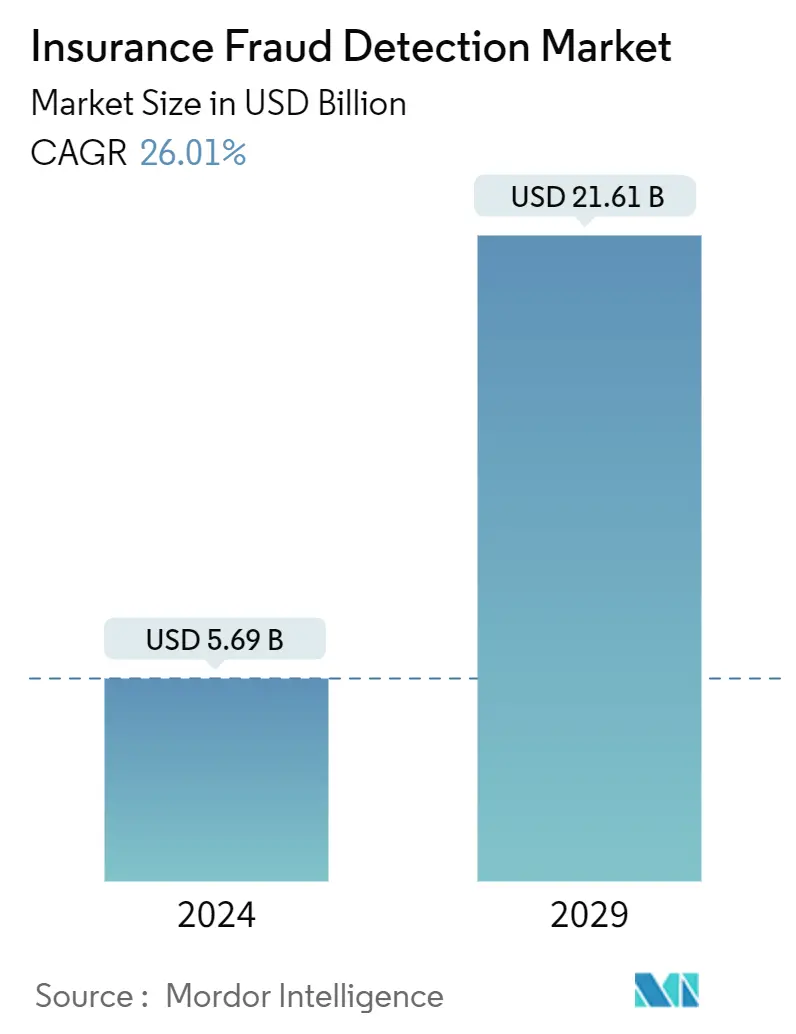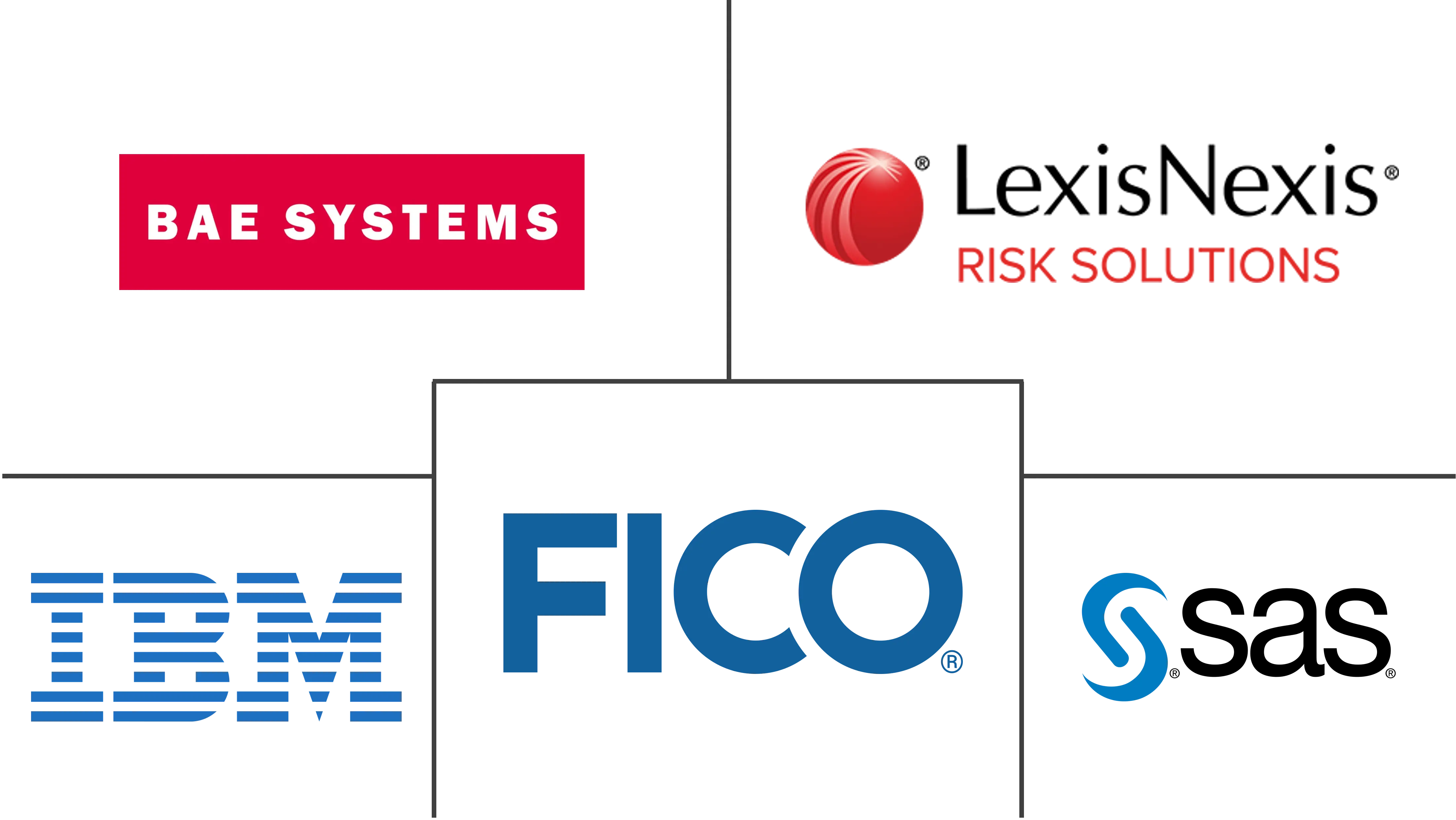Market Size of Insurance Fraud Detection Industry

| Study Period | 2019-2029 |
| Market Size (2024) | USD 5.69 Billion |
| Market Size (2029) | USD 21.61 Billion |
| CAGR (2024 - 2029) | 26.01 % |
| Fastest Growing Market | Asia Pacific |
| Largest Market | North America |
Major Players
*Disclaimer: Major Players sorted in no particular order |
Insurance Fraud Detection Market Analysis
The Insurance Fraud Detection Market size is estimated at USD 5.69 billion in 2024, and is expected to reach USD 21.61 billion by 2029, growing at a CAGR of 26.01% during the forecast period (2024-2029).
The increasing number of fraud claims and their burden on insurance businesses, the need to efficiently manage large amounts of policyholder data, and improved operational efficiency to enhance customer experience are the key factors fueling the market's growth.
- The insurance industry's embrace of automation has paced the application processing, underwriting, and claims processes and opened ways to new fraud types throughout the insurance life cycle. The digital shift gave rise to digital experiences and automated premium calculation processes, opening new opportunities for fraudsters. Thus, the use of AI insurance fraud tools is growing considerably.
- The need to effectively manage vast volumes of identities plays a pivotal role in shaping the insurance fraud detection market, reflecting the industry's response to the evolving challenges posed by identity-related risks. As the insurance sector undergoes digital transformation, the large volume and diversity of identities involved in transactions, claims processing, and interactions have risen. This surge in data complexity necessitates a sophisticated approach to identity management, making it a critical market driver for insurers.
- Improved operational efficiency and enhanced customer experience represent a comprehensive approach within the insurance fraud detection market. It signifies a shift from traditional, segregated fraud prevention methods to a more integrated strategy prioritizing the insurer's internal workings and the policyholder's external experience.
- The insurance industry's awareness and comprehension of these technologies are crucial for the efficacy of fraud detection systems in the current landscape of rapid technological developments and shifting fraud strategies. However, widespread ignorance might pose a significant barrier to adopting and effectively applying advanced fraud detection technologies.
- The COVID-19 pandemic had a long-term impact on several industries, notably the market for insurance fraud detection. The insurance sector witnessed changes in fraudulent activity patterns as the world faced previously unrecognized challenges, which led to a reassessment of fraud detection techniques.
- The COVID-19 pandemic accelerated digitalization in the insurance business, providing the sector with improved instruments to fight fraud across the policy lifecycle. As per FRISS's survey, which involved 400 insurance professionals worldwide, 53% anticipated that anti-fraud technology would aid them in remaining ahead of emerging fraudulent schemes. In contrast, 52% look forward to enhanced investigator efficiency. As per a recent FRISS survey, for 59% of respondents in the insurance sector, fraud detection software is expected to enhance the loss ratio. The increased adoption of digital tools and technology, as indicated by improved tools to fight fraud, reflects the industry's response to the challenges posed by the dynamic fraud landscape during and after the pandemic.
Insurance Fraud Detection Industry Segmentation
Insurance fraud detection software prevents, detects, and manages fraud across the enterprise, making smarter decisions, increasing return on capital, and driving business performance. The global insurance fraud detection market is defined based on the revenues generated from the solutions and services used by various end users across the globe. The analysis is based on the market insights captured through secondary research and the primaries. The market also covers the major factors impacting the market’s growth in terms of drivers and restraints.
The insurance fraud detection market is segmented by component (solution [fraud analytics, authentication, governance, risk, and compliance, and other solutions] and service), by application (claims fraud, identity theft, payment and billing fraud, and money laundering), by end-user industry (automotive, BFSI, healthcare, and retail), and by geography (North America [United States and Canada], Europe [United Kingdom, Germany, France, and Rest of Europe], Asia-Pacific [China, Japan, India, and Rest of Asia Pacific], Latin America, and Middle East and Africa). The report offers market forecast and size in USD for all the above segments.
| By Component | ||||||
| ||||||
| Service |
| By Applcation | |
| Claims Fraud | |
| Identity Theft | |
| Payment and Billing Fraud | |
| Money Laundering |
| By End-user Indsutry | |
| Automotive | |
| BFSI | |
| Healthcare | |
| Retail | |
| Other End-user Industries |
| By Geography | ||||||
| ||||||
| ||||||
| ||||||
| Latin America | ||||||
| Middle East and Africa |
Insurance Fraud Detection Market Size Summary
The insurance fraud detection market is experiencing significant growth, driven by the increasing prevalence of fraudulent claims and the need for insurers to manage vast amounts of policyholder data efficiently. The digital transformation within the insurance industry has accelerated the adoption of automation, enhancing processes such as underwriting and claims handling. However, this shift has also introduced new types of fraud, necessitating the use of advanced technologies like artificial intelligence and machine learning to detect and prevent fraudulent activities. The market is characterized by a comprehensive approach that integrates operational efficiency with improved customer experiences, moving away from traditional, isolated fraud prevention methods. Despite the potential barriers posed by a lack of awareness and understanding of these technologies, the market is poised for substantial growth as insurers seek to mitigate losses from fraud.
The COVID-19 pandemic has further accelerated the digitalization of the insurance sector, prompting a reassessment of fraud detection techniques and the adoption of digital tools to combat evolving fraud patterns. The market is supported by the increasing demand for fraud analytic solutions, which leverage predictive modeling to identify and prioritize potential fraud cases, thereby reducing financial losses and protecting the insurer's reputation. The BFSI sector, particularly insurance companies, drives the market's growth by implementing these solutions to safeguard against fraudulent claims. The rising sophistication of fraud, coupled with the growing acceptance of technology among younger consumers, underscores the need for robust fraud detection systems. As competition intensifies, market players are focusing on partnerships and acquisitions to enhance their offerings and maintain a competitive edge.
Insurance Fraud Detection Market Size - Table of Contents
-
1. MARKET INSIGHTS
-
1.1 Market Overview
-
1.2 Industry Stakeholder Analysis
-
1.3 Industry Attractiveness - Porter's Five Forces Analysis
-
1.3.1 Bargaining Power of Suppliers
-
1.3.2 Bargaining Power of Consumers
-
1.3.3 Threat of New Entrants
-
1.3.4 Threat of Substitute Products
-
1.3.5 Intensity of Competitive Rivalry
-
-
-
2. MARKET SEGMENTATION
-
2.1 By Component
-
2.1.1 Solution
-
2.1.1.1 Fraud Analytics
-
2.1.1.2 Authentication
-
2.1.1.3 Governance, Risk, and Compliance
-
2.1.1.4 Other Solutions
-
-
2.1.2 Service
-
-
2.2 By Applcation
-
2.2.1 Claims Fraud
-
2.2.2 Identity Theft
-
2.2.3 Payment and Billing Fraud
-
2.2.4 Money Laundering
-
-
2.3 By End-user Indsutry
-
2.3.1 Automotive
-
2.3.2 BFSI
-
2.3.3 Healthcare
-
2.3.4 Retail
-
2.3.5 Other End-user Industries
-
-
2.4 By Geography
-
2.4.1 North America
-
2.4.1.1 United States
-
2.4.1.2 Canada
-
-
2.4.2 Europe
-
2.4.2.1 United Kingdom
-
2.4.2.2 Germany
-
2.4.2.3 France
-
-
2.4.3 Asia-Pacific
-
2.4.3.1 China
-
2.4.3.2 Japan
-
2.4.3.3 India
-
2.4.3.4 Rest of Asia Pacific
-
-
2.4.4 Latin America
-
2.4.5 Middle East and Africa
-
-
Insurance Fraud Detection Market Size FAQs
How big is the Insurance Fraud Detection Market?
The Insurance Fraud Detection Market size is expected to reach USD 5.69 billion in 2024 and grow at a CAGR of 26.01% to reach USD 21.61 billion by 2029.
What is the current Insurance Fraud Detection Market size?
In 2024, the Insurance Fraud Detection Market size is expected to reach USD 5.69 billion.

